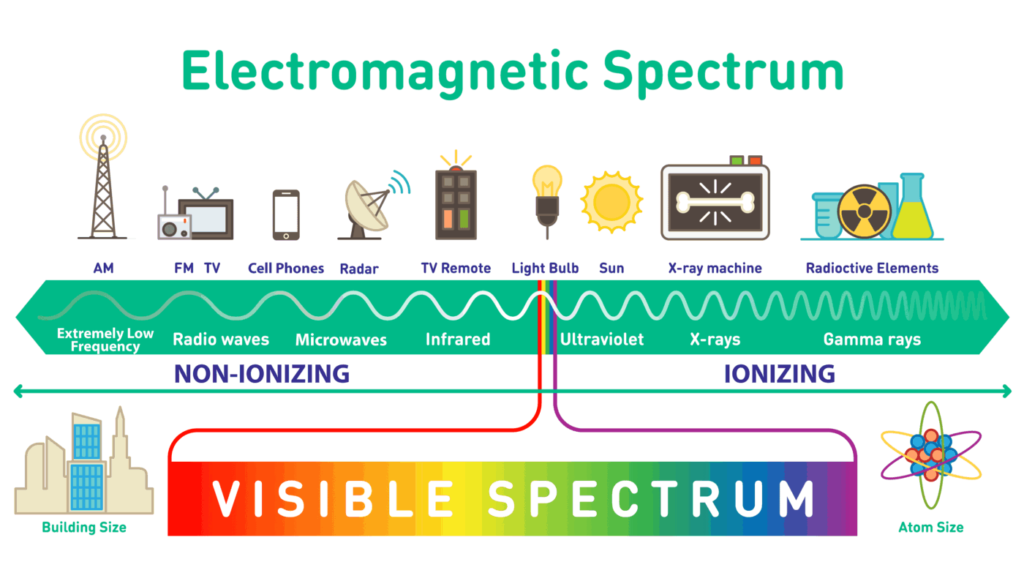Visible light is much more complex than you think!
Light is made up of electromagnetic particles that travels in waves. However, these waves emit energy, and range in length and strength. Therefore, the shorter the wavelength; the higher the energy.
Every wavelength is represented by a different colo,r, and is grouped into the following categories, that is, Gamma rays, X-Rays, Ultraviolet (UV) rays, visible light, infrared light, and radio waves. Together all these wavelengths build up the electromagnetic spectrum. But, the human eye is only able to see certain part of this spectrum, which is, Visible Light. And that, the visible light in the electromagnetic spectrum is seen as Violet, Indigo, Blue, Green, Yellow, Orange and Red.

“Blue Light” is a color in the “visible light spectrum” that can be seen by the human eyes. It has a very short wavelength, and so it produces a higher amount of energy. Studies suggest that, over time, exposure to the blue light could cause serious long-term damage to the eyes.
Blue Light has a wavelength of between approximately 380nm to 500nm; making it one of the shortest, highest-energy wavelengths.
UVEX-SAFETY UK

Blue Light is everywhere. When you go outside your house, the light travels from the sun through the atmosphere. It used to be that the only source of natural blue light is from the sun. Now, we have artificial blue light emitting from digital screens form the TV, smartphones, computers, laptops, tablets, and gaming systems, electronic devices, LED and fluorescent lighting.
Natural blue light comes from the sun. The light travels from the sun through the atmosphere. The short and high energy of the blue wavelengths collide with the air molecules causing it to scatter everywhere. That explains why the sky is blue. Naturally, the human body uses the natural blue light from the sun to regulate the sleep and wake cycles, which is known as the circadian rhythm.
For your information, natural blue light also helps in boosting alertness, heighten reaction times, elevate moods, and increase the feeling of well-being. However, artificial sources of blue light includes electronic devices such as cellphones, and laptops, as well as energy-saving fluorescent bulbs and LED lights. Expose to artificial blue light in the long run will had side effects towards the body health.
YES YOU SHOULD!!
Blue light waves are among the shortest and highest energy wavelengths in the electromagnetic spectrum chart. It flickers mroe easily than longer, weaker wavelengths due to its short and high wavelengths. We called it “BLUE” or “HIGH ENERGY VISIBLE (HEV)” wavelengths. Such flickering is able to create glare that is reduces visual contrast and affect sharpness and clarity.
In the long run, it creates eyestrain, headaches, physical and mental fatigue due to long hours sitting in front of the laptop screen or other electronic devices.
Our eye’ natural filters do not provide sufficient protection against blue light rays from the sun; Let alone, the blue light emanating from these man-made devices and fluorescent light tubes. Prolong exposure to these artificial blue light may cause retinal damage and contribute to age-related macular degeneration, which leads to vision loss.



References:
1Noseda R, Bernstein CA, Nir R-R, et al. Migraine photophobia originating in cone-driven retinal pathways. Brain. 2016;139(7):1971-1986. doi:10.1093/brain/aww119.
2Main A, Vlachonikolis I, Dowson A. The wavelength of light causing photophobia in migraine and tension-type headache between attacks. Headache. 2000 Mar;40(3):194-9.
3M. Tatsumoto, T. Eda, T. Ishikawa, M. Ayama, K. Hirata. Light of Intrinsically Photosensitive Retinal Ganglion Cell (ipRGC) Causing Migraine Headache Exacerbation. IHC symposium OR3. 2013 June.
4Kim DJ, Lim C-Y, Gu N, Park CY. Visual Fatigue Induced by Viewing a Tablet Computer with a High-resolution Display. Korean Journal of Ophthalmology : KJO. 2017;31(5):388-393. doi:10.3341/kjo.2016.0095.
5Ranasinghe P, Wathurapatha WS, Perera YS, et al. Computer vision syndrome among computer office workers in a developing country: an evaluation of prevalence and risk factors. BMC Research Notes. 2016;9:150. doi:10.1186/s13104-016-1962-1.
6Kaido M, Toda I, Oobayashi T, Kawashima M, Katada Y, Tsubota K. Reducing Short-Wavelength Blue Light in Dry Eye Patients with Unstable Tear Film Improves Performance on Tests of Visual Acuity. Stieger K, ed. PLoS ONE. 2016;11(4):e0152936. doi:10.1371/journal.pone.0152936.
7Kayaba M, Iwayama K, Ogata H, et al. The effect of nocturnal blue light exposure from light-emitting diodes on wakefulness and energy metabolism the following morning. Environmental Health and Preventive Medicine. 2014;19(5):354-361. doi:10.1007/s12199-014-0402-x.
8Chang A-M, Aeschbach D, Duffy JF, Czeisler CA. Evening use of light-emitting eReaders negatively affects sleep, circadian timing, and next-morning alertness. Proceedings of the National Academy of Sciences of the United States of America. 2015;112(4):1232-1237. doi:10.1073/pnas.1418490112.
9Narimatsu T, Ozawa Y, Miyake S, Kubota S, Yuki K, Nagai N, Tsubota K. Biological effects of blocking blue and other visible light on the mouse retina. Clin Exp Ophthalmol. 2014 Aug;42(6):555-63. doi: 10.1111/ceo.12253. Epub 2013 Dec 4.
10Vicente-Tejedor J, Marchena M, Ramírez L, et al. Removal of the blue component of light significantly decreases retinal damage after high intensity exposure. Barnes S, ed. PLoS ONE. 2018;13(3):e0194218. doi:10.1371/journal.pone.0194218.
11Zrenner E. [Light-induced damage to the eye]. [Article in German] Fortschr Ophthalmol. 1990;87 Suppl:S41-51.
12Alkozei A, Smith R, Pisner DA, et al. Exposure to Blue Light Increases Subsequent Functional Activation of the Prefrontal Cortex During Performance of a Working Memory Task. Sleep. 2016;39(9):1671-1680. doi:10.5665/sleep.6090.
13Bajaj S, Vanuk JR, Smith R, Dailey NS, Killgore WDS. Blue-Light Therapy following Mild Traumatic Brain Injury: Effects on White Matter Water Diffusion in the Brain. Frontiers in Neurology. 2017;8:616. doi:10.3389/fneur.2017.00616.